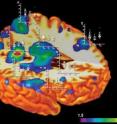Brain abnormalities identified that result from prenatal meth exposure
Related images
(click to enlarge)
Children whose mothers abused methamphetamine (meth) during pregnancy show brain abnormalities that may be more severe than that of children exposed to alcohol prenatally, according to a study in the March 17 issue of The Journal of Neuroscience. While researchers have long known that drug abuse during pregnancy can alter fetal brain development, this finding shows the potential impact of meth. Identifying vulnerable brain structures may help predict particular learning and behavioral problems in meth-exposed children. "We know that alcohol exposure is toxic to the developing fetus and can result in lifelong brain, cognitive, and behavioral problems," said Elizabeth Sowell, PhD, of the University of California, Los Angeles, who led the research team. "In this study, we show that the effects of prenatal meth exposure, or the combination of meth and alcohol exposure, may actually be worse. Our findings stress the importance of drug abuse treatment for pregnant women," Sowell said. A structure called the caudate nucleus, which is important for learning and memory, motor control, and motivation, was one of the regions more reduced by meth than alcohol exposure.
Of the more than 16 million Americans over the age of 12 who have used meth, about 19,000 are pregnant women, according to data from the National Surveys on Drug Use and Health. About half of women who say they used meth during pregnancy also used alcohol, so isolating the effects of meth on the developing brain is difficult.
Sowell's team evaluated the specific effects of prenatal meth-exposure by comparing brain scans of 61 children: 21 with prenatal meth and alcohol exposure, 13 with heavy alcohol exposure only, and 27 unexposed. Structural magnetic resonance imaging (MRI) showed that the sizes and shapes of certain brain structures varied depending on prenatal drug exposure.
Previous studies have shown that certain brain structures are smaller in alcohol-exposed children. In this study, the authors found these brain regions in meth-exposed children were similar to the alcohol-exposed children, and in some areas were smaller still. Some brain regions were larger than normal. An abnormal volume increase was noted in meth-exposed children in a region called the cingulate cortex, which is associated with control and conflict resolution.
The researchers were also able to predict a child's past exposure to drugs based on brain images and IQ information. Detailed data about vulnerable brain structures may eventually be used to diagnose children with cognitive or behavioral problems but without well-documented histories of drug exposure. Christian Beaulieu, PhD, of the University of Alberta in Canada, who was unaffiliated with the study, said this finding will help researchers understand which brain areas are most sensitive to injury during development.
"Ultimately, the goal would be to come up with strategies to first, minimize brain damage in the womb, and second, to improve the child's cognitive performance," Beaulieu said.
Source: Society for Neuroscience
Articles on the same topic
- Researchers ID brain abnormalities in children exposed to methamphetamine in uteroTue, 16 Mar 2010, 22:16:21 UTC
Other sources
- Researchers ID brain abnormalities in children exposed to methamphetamine in uterofrom Science BlogWed, 17 Mar 2010, 11:42:44 UTC
- Brain abnormalities identified that result from prenatal methamphetamine exposurefrom Science DailyWed, 17 Mar 2010, 3:21:25 UTC
- Researchers ID brain abnormalities in children exposed to methamphetamine in uterofrom Science BlogTue, 16 Mar 2010, 22:49:19 UTC
- Brain abnormalities identified that result from prenatal meth exposurefrom PhysorgTue, 16 Mar 2010, 22:07:24 UTC
